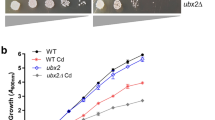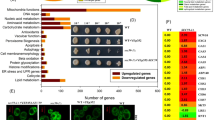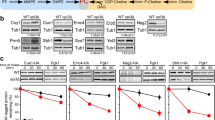Abstract
Accumulation of misfolded/unfolded proteins in the endoplasmic reticulum (ER) induces ER stress. The transcription factor RPN4 {“Regulatory Particle Non-ATPase”} regulates protein homeostasis by degrading proteins that elude proper folding or assembly via the proteasomal degradation pathway. Here, we studied the lipid alterations exerted by Saccharomyces cerevisiae to mitigate (ER) stress during adaptive responses in rpn4∆ cells. The loss of RPN4-induced ER stress increased phospholipid synthesis, leading to altered membrane structures and accumulation of neutral lipids, causing an increase in lipid droplets (LDs). There was a significant upregulation of genes involved in neutral lipid and membrane lipid synthesis in rpn4∆ cells. Overexpression of RPN4 restored the defects caused by rpn4∆ cells. Thus, our study provides new insight that RPN4 impacts lipid homeostasis.








Similar content being viewed by others
Data availability
All data generated or analyzed during this study are included in this published article (and its supplementary information files).
References
Chadwick SR, Lajoie P (2019) Endoplasmic reticulum stress coping mechanisms and life span regulation in health and diseases. Front Cell Dev Biol 7:84. https://doi.org/10.3389/fcell.2019.00084
Vembar SS, Brodsky JL (2008) One-step at a time: endoplasmic reticulum-associated degradation. Nat Rev Mol Cell Biol 9:944–957. https://doi.org/10.1038/nrm2546
Xie Y, Varshavsky A (2001) RPN4 is a ligand, substrate, and transcriptional regulator of the 26S proteasome: a negative feedback circuit. Proc Natl Acad Sci USA 98:3056–3061. https://doi.org/10.1073/pnas.071022298
Mannhaupt G, Schnall R, Karpov V, Vetter I, Feldmann H (1999) Rpn4p acts as a transcription factor by binding to PACE, a nonamer box found upstream of 26S proteasomal and other genes in yeast. FEBS Lett 450:27–34. https://doi.org/10.1016/s0014-5793(99)00467-6
Vermitsky JP, Earhart KD, Smith WL, Homayouni R, Edlind TD, Rogers PD (2006) Pdr1 regulates multidrug resistance in Candida glabrata: gene disruption and genome-wide expression studies. Mol Microbiol 61:704–722. https://doi.org/10.1111/j.1365-2958.2006.05235.x
Karpov DS, Grineva EN, Kiseleva SV, Chelarskaya ES, Spasskaya DS, Karpov VL (2019) Candida glabrata Rpn4-like protein complements the RPN4 deletion in Saccharomyces cerevisiae. Mol Biol (Mosk) 53:274–281. https://doi.org/10.1134/S002689841902006X
Fagone P, Jackowski S (2009) Membrane phospholipid synthesis and endoplasmic reticulum function. J Lipid Res 50:311–316. https://doi.org/10.1194/jlr.R800049-JLR200
Muthukumar K, Rajakumar S, Sarkar MN, Nachiappan V (2011) Glutathione peroxidase3 of Saccharomyces cerevisiae protects phospholipids during cadmium-induced oxidative stress. Antonie Van Leeuwenhoek 99:761–771. https://doi.org/10.1007/s10482-011-9550-9
Rajakumar S, Bhanupriya N, Ravi C, Nachiappan V (2016) Endoplasmic reticulum stress and calcium imbalance are involved in cadmium-induced lipid aberrancy in Saccharomyces cerevisiae. Cell Stress Chaperones 21:895–906. https://doi.org/10.1007/s12192-016-0714-4
James AW, Gowsalya R, Nachiappan V (1861) Dolichyl pyrophosphate phosphatase-mediated N-glycosylation defect dysregulates lipid homeostasis in Saccharomyces cerevisiae. Biochim Biophys Acta 2016:1705–1718. https://doi.org/10.1016/j.bbalip.2016.08.004
James AW, Ravi C, Srinivasan M, Nachiappan V (2019) Crosstalk between protein N-glycosylation and lipid metabolism in Saccharomyces cerevisiae. Sci Rep 9:14485. https://doi.org/10.1038/s41598-019-51054-7
Fei W, Wang H, Fu X, Bielby C, Yang H (2009) Conditions of endoplasmic reticulum stress stimulate lipid droplet formation in Saccharomyces cerevisiae. Biochem J 23:61–67. https://doi.org/10.1042/BJ2009085
Travers KJ, Patil CK, Wodicka L, Lockhart DJ, Weissman JS, Walter P (2000) Functional and genomic analyses reveal an essential coordination between the unfolded protein response and ER associated degradation. Cell 101:249–258. https://doi.org/10.1016/s0092-8674(00)80835-1
Thibault G, Ismail N, Ng DT (2011) The unfolded protein response supports cellular robustness as a broad-spectrum compensatory pathway. Proc Natl Acad Sci USA 108:20597–20602. https://doi.org/10.1073/pnas.1117184109
Thibault G, Shui G, Kim W, McAlister GC, Ismail N, Gygi SP, Wenk MR, Ng DT (2012) The membrane stress response buffers lethal effects of lipid disequilibrium by reprogramming the protein homeostasis network. Mol Cell 48:16–27. https://doi.org/10.1016/j.molcel.2012.08.016
Volmer R, Ron D (2015) Lipid-dependent regulation of the unfolded protein response. Curr Opin Cell Biol 33:67–73. https://doi.org/10.1016/j.ceb.2014.12.002
Ho N, Xu C, Thibault G (2018) From the unfolded protein response to metabolic diseases—lipids under the spotlight. J Cell Sci. https://doi.org/10.1242/jcs.199307
Schmidt RM, Schessner JP, Borner GH, Schuck S (2019) The proteasome biogenesis regulator Rpn4 cooperates with the unfolded protein response to promote ER stress resistance. Elife 8:e43244. https://doi.org/10.7554/eLife.43244
Selvaraju K, Rajakumar S, Nachiappan V (1842) Identification of a phospholipase B encoded by the LPL1 gene in Saccharomyces cerevisiae. Biochim Biophys Acta 2014:1383–1392. https://doi.org/10.1016/j.bbalip.2014.06.013
Weisshaar N, Welsch H, Guerra-Moreno A, Hanna J (2017) Phospholipase Lpl1 links lipid droplet function with quality control protein degradation. Mol Biol Cell 28:716–725. https://doi.org/10.1091/mbc.E16-10-0717
Gietz RD, Schiestl RH (2007) High-efficiency yeast transformation using the LiAc/SS carrier DNA/PEG method. Nat Protoc 2:31–34. https://doi.org/10.1038/nprot.2007.13
Shirozu R, Yashiroda H, Murata S (2015) Identification of minimum Rpn4-responsive elements in genes related to proteasome functions. FEBS Lett 589:933–940. https://doi.org/10.1016/j.febslet.2015.02.025
Bligh EG, Dyer WJ (1959) A rapid method of total lipid extraction and purification. Can J Biochem Physiol 37:911–917. https://doi.org/10.1139/o59-099
Yadav PK, Rajasekharan R (2016) Misregulation of a DDHD domain containing lipase causes mitochondrial dysfunction in yeast. J Biol Chem 291:18562–18581. https://doi.org/10.1074/jbc.M116.733378
Siakotos AN, Rouser G, Fleischer S (1969) Phospholipid composition of human, bovine and frog myelin isolated on a large from brain and spinal cord. Lipids 4:239–242. https://doi.org/10.1007/bf02532639
Block-Alper L, Webster P, Zhou X, Supekova L, Wong WH, Schultz PG, Meyer DI (2002) IN02, a positive regulator of lipid biosynthesis, is essential for the formation of inducible membranes in yeast. Mol Biol Cell 13:40–51. https://doi.org/10.1091/mbc.01-07-0366
Livak KJ, Schmittgen TD (2001) Analysis of relative gene expression data using real-time quantitative PCR and the 2(−Delta Delta C (T)) method. Methods 25:402–408. https://doi.org/10.1006/meth.2001.1262
Gardarin A, Chedin S, Lagniel G, Aude JC, Godat E, Catty P, Labarre J (2010) Endoplasmic reticulum is a major target of cadmium toxicity in yeast. Mol Microbiol 76:1034–1048. https://doi.org/10.1111/j.1365-2958.2010.07166.x
Bradford MM (1976) A rapid and sensitive method for the quantitation of microgram quantities of protein utilizing the principle of protein-dye binding. Anal Biochem 72:248–254. https://doi.org/10.1006/abio.1976.9999
Hou J, Tang H, Liu Z, Osterlund T, Nielsen J, Petranovic D (2014) Management of the endoplasmic reticulum stress by activation of the heat shock response in yeast. FEMS Yeast Res 14:481–494. https://doi.org/10.1111/1567-1364.12125
Wang X, Xu H, Ju D, Xie Y (2008) Disruption of Rpn4-induced proteasome expression in Saccharomyces cerevisiae reduces cell viability under stressed conditions. Genetics 180:1945–1953. https://doi.org/10.1534/genetics.108.094524
Penno A, Hackenbroich G, Thiele C (1831) Phospholipids and lipid droplets. Biochim Biophys Acta 2013:589–594. https://doi.org/10.1016/j.bbalip.2012.12.001
Greenberg ML, Klig LS, Letts VA, Loewy BS, Henry SA (1983) Yeast mutant defective in phosphatidylcholine synthesis. J Bacteriol 153:791–799. https://doi.org/10.1128/jb.153.2.791-799.1983
Trotter PJ, Voelker DR (1995) Identification of a non-mitochondrial phosphatidylserine decarboxylase activity (PSD2) in the yeast Saccharomyces cerevisiae. J Biol Chem 270:6062–6070. https://doi.org/10.1074/jbc.270.11.6062
Murata Y, Watanabe T, Sato M, Momose Y, Nakahara T, Oka S, Iwahashi H (2003) Dimethyl sulfoxide exposure facilitates phospholipid biosynthesis and cellular membrane proliferation in yeast cells. J Biol Chem 278:33185–33193. https://doi.org/10.1074/jbc.M300450200
Ruegsegger U, Leber JH, Walter P (2001) Block of HAC1 mRNA translation by long-range base pairing is released by cyto-plasmic splicing upon induction of the unfolded protein response. Cell 107:103–114. https://doi.org/10.1016/s0092-8674(01)00505-0
Fei W, Zhong L, Ta MT, Shui G, Wenk MR, Yang H (2011) The size and phospholipid composition of lipid droplets can influence their proteome. Biochem Biophys Res Commun 415:455–462. https://doi.org/10.1016/j.bbrc.2011.10.091
Oelkers P, Tinkelenberg A, Erdeniz N, Cromley D, Billheimer JT, Sturley SL (2000) A lecithin cholesterol acyltransferase-like gene mediates diacylglycerol esterification in yeast. J Biol Chem 275:15609–15612. https://doi.org/10.1074/jbc.C000144200
Sorger D, Daum G (2003) Triacylglycerol biosynthesis in yeast. Appl Microbiol Biotechnol 61:289–299. https://doi.org/10.1007/s00253-002-1212-4
Smith SW, Weiss SB, Kennedy EP (1957) The enzymatic dephosphorylation of phosphatidic acids. J Biol Chem 228:915–922
Pascual F, Carman GM (1831) Phosphatidate phosphatase, a key regulator of lipid homeostasis. Biochim Biophys Acta 2013:514–522. https://doi.org/10.1016/j.bbalip.2012.08.006
Pascual F, Hsieh LS, Soto-Cardalda A, Carman GM (2014) Yeast Pah1p phosphatidate phosphatase is regulated by proteasome-mediated degradation. J Biol Chem 289:9811–9822. https://doi.org/10.1074/jbc.M114.550103
Han GS, O’Hara L, Carman GM, Siniossoglou S (2008) An unconventional diacylglycerol kinase that regulates phospholipid synthesis and nuclear membrane growth. J Biol Chem 283:20433–20442. https://doi.org/10.1074/jbc.M802903200
Kimata Y, Kohno K (2011) Endoplasmic reticulum stress-sensing mechanisms in yeast and mammalian cells. Curr Opin Cell Biol 23:135–142. https://doi.org/10.1016/j.ceb.2010.10.008
Gething MJ (1999) Role and regulation of the ER chaperone BiP. Semin Cell Dev Biol 10:465–472. https://doi.org/10.1006/scdb.1999.0318
Lajoie P, Moir RD, Willis IM, Snapp EL (2012) Kar2p availability defines distinct forms of endoplasmic reticulum stress in living cells. Mol Biol Cell 23:955–964. https://doi.org/10.1091/mbc.E11-12-0995
Jonikas MC, Collins SR, Denic V, Oh E, Quan EM, Schmid V, Weibezahn J, Schwappach B, Walter P, Weissman JS, Schuldiner M (2009) Comprehensive characterization of genes required for protein folding in the endoplasmic reticulum. Science 323:1693–1697. https://doi.org/10.1126/science.1167983
Ambroziak J, Henry SA (1994) INO2 and INO4 gene products, positive regulators of phospholipid biosynthesis in Saccharomyces cerevisiae, form a complex that binds to the INO1 promoter. J Biol Chem 269:15344–15349
Schuck S, Prinz WA, Thorn KS, Voss C, Walter P (2009) Membrane expansion alleviates endoplasmic reticulum stress independently of the unfolded protein response. J Cell Biol 187:525–536. https://doi.org/10.1083/jcb.200907074
Acknowledgements
The author NB was supported by a fellowship (IF150823) from DST-INSPIRE, New Delhi, India. We also thank the UGC-BSR grant for providing financial assistance. We thank DST-FIST for providing infrastructure in the Department of Biochemistry and DST-PURSE for providing the confocal facility at Bharathidasan University. We sincerely thank Prof. J.W. Hanna (Department of Pathology, Brigham and Women’s Hospital and Harvard Medical school, Boston) USA, for gifting us the mutant strain. We thank Prof. Shigeo Murata (Laboratory of Protein Metabolism, The University of Tokyo, Japan) and Prof. Anne Skaja Robinson (Department of Chemical and Biomolecular Engineering, Tulane University, USA) for gifting the overexpression plasmid pYES2-RPN4 and UPRE-GFP. We thank Prof. Jeffrey L. Brodsky (Department of Cell Biology, University of Pittsburgh, USA) for providing Kar2 antibodies. We thank Prof. Ram Rajasekharan, Head Department of Microbiology, Central University of Tamil Nadu, Thiruvarur, India, for providing reagents for this study.
Funding
This work is supported by the UGC-BSR faculty fellowship grant [F4-5(11)/2019(BSR)],New Delhi,India and INSPIRE fellowship [IF150823],DST,New Delhi, India.
Author information
Authors and Affiliations
Contributions
Conceived and designed the experiments: BN, AWJ, and VN. Experiments performed: BN. Analyzing data: BN and VN. Drafted the manuscript: BN, AM, and VN; all the authors reviewed the manuscript.
Corresponding author
Ethics declarations
Competing interests
The authors declare no competing interests.
Additional information
Publisher's Note
Springer Nature remains neutral with regard to jurisdictional claims in published maps and institutional affiliations.
Supplementary Information
Below is the link to the electronic supplementary material.
Rights and permissions
Springer Nature or its licensor (e.g. a society or other partner) holds exclusive rights to this article under a publishing agreement with the author(s) or other rightsholder(s); author self-archiving of the accepted manuscript version of this article is solely governed by the terms of such publishing agreement and applicable law.
About this article
Cite this article
Nagaraj, B., James, A.W., Mathivanan, A. et al. Impairment of RPN4, a transcription factor, induces ER stress and lipid abnormality in Saccharomyces cerevisiae. Mol Cell Biochem 478, 2127–2139 (2023). https://doi.org/10.1007/s11010-022-04623-w
Received:
Accepted:
Published:
Issue Date:
DOI: https://doi.org/10.1007/s11010-022-04623-w




